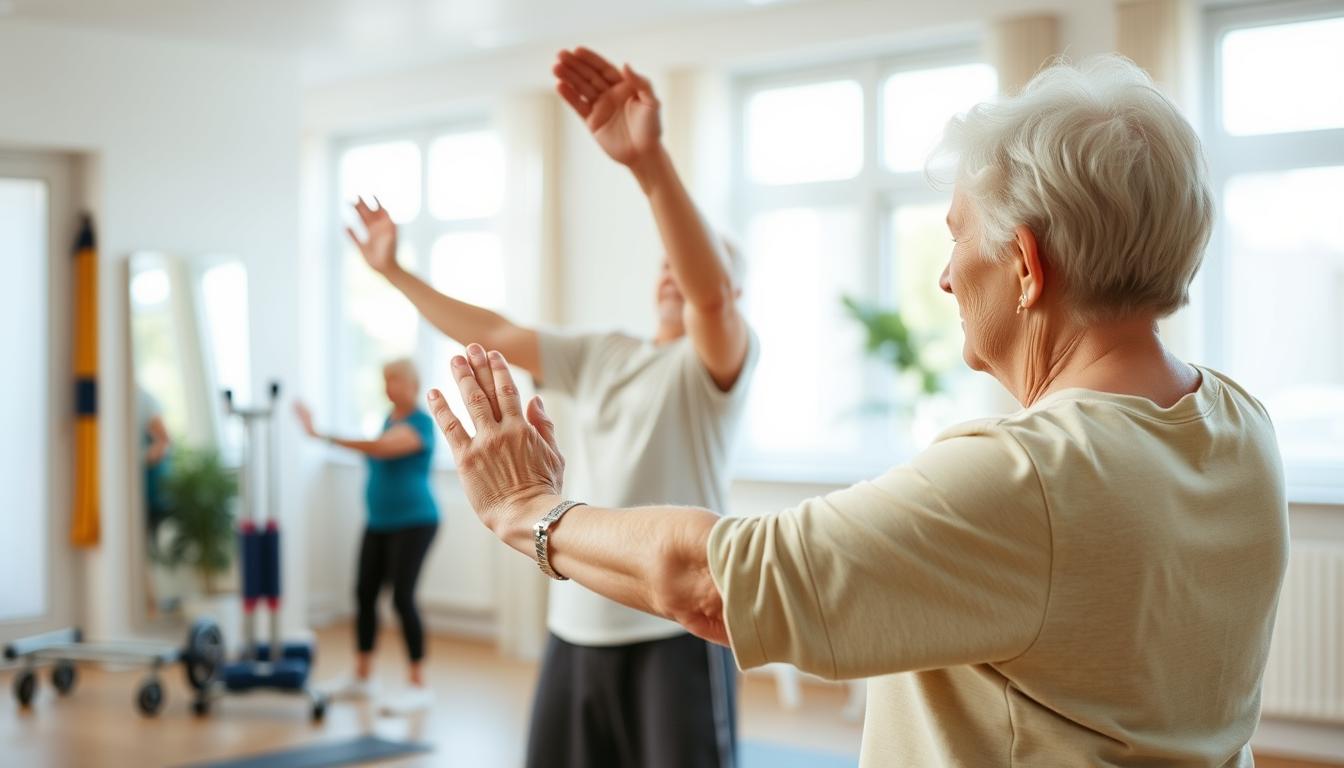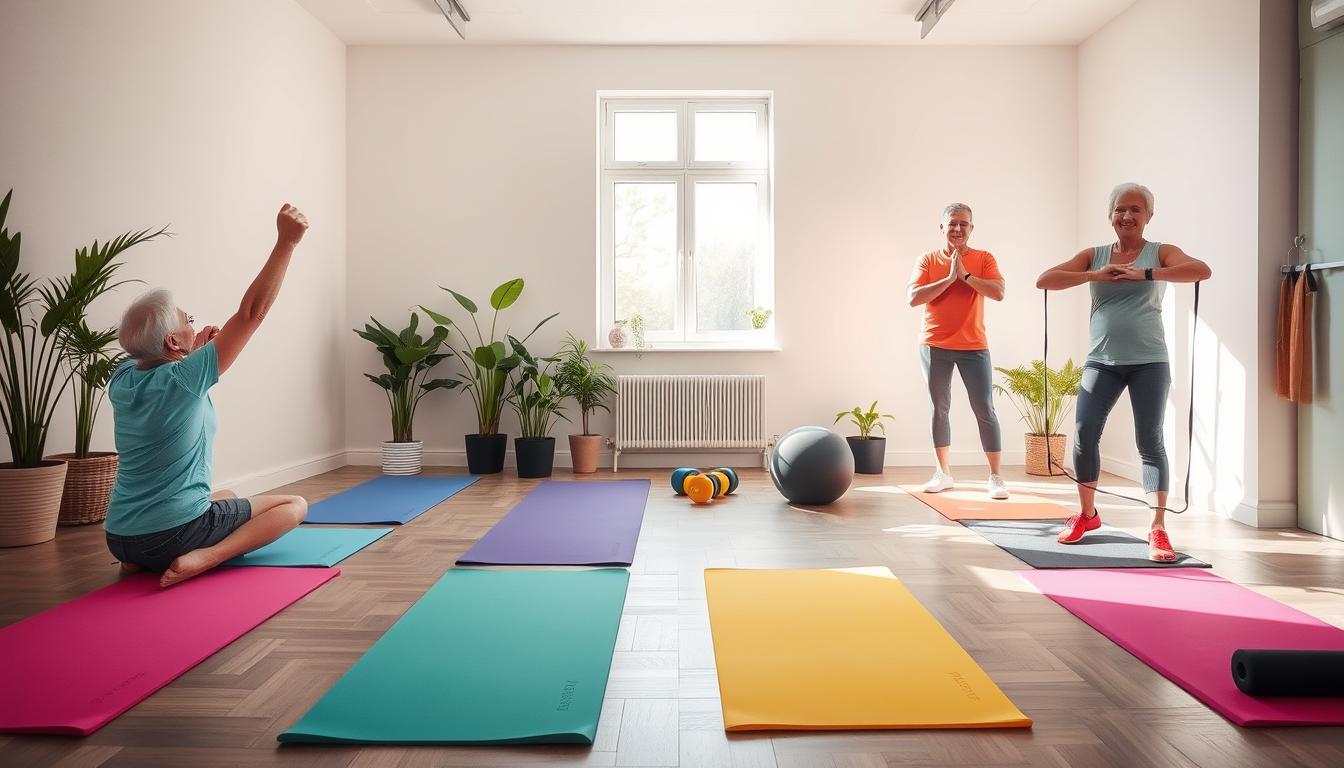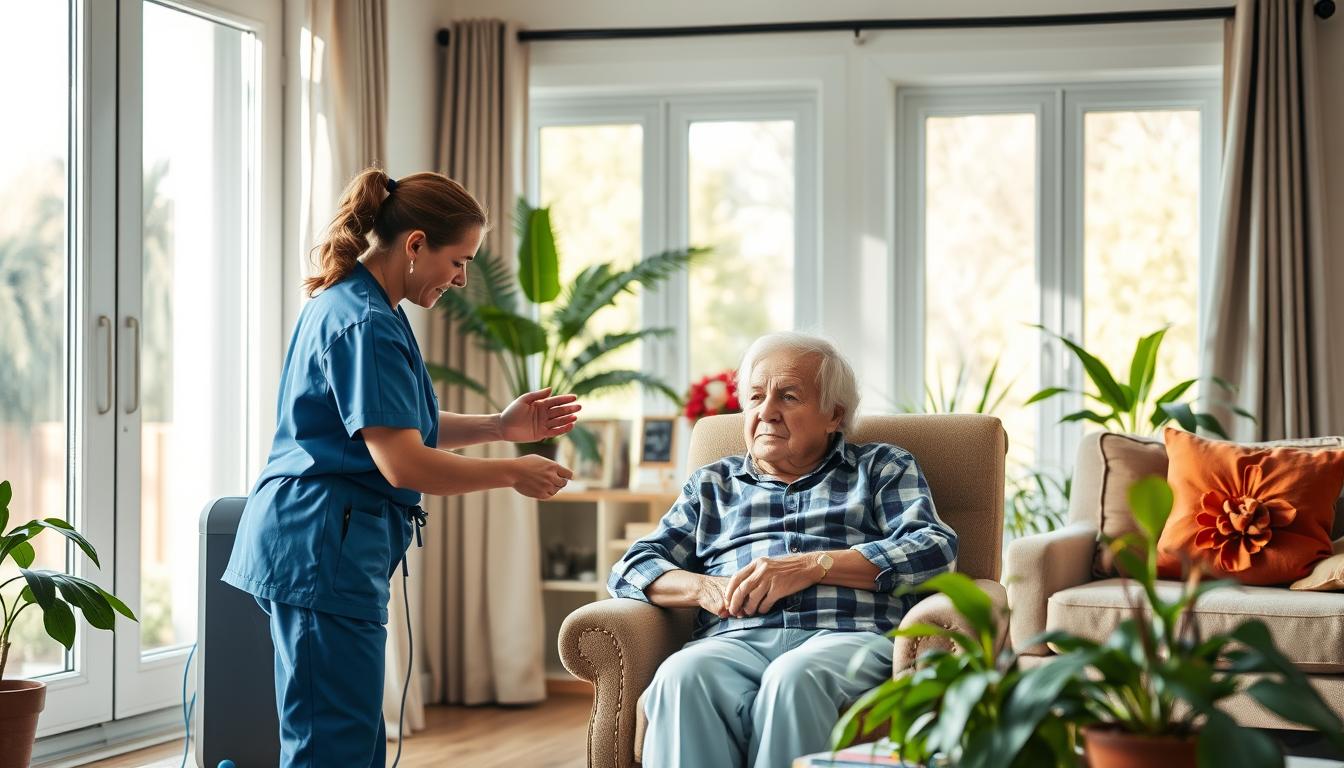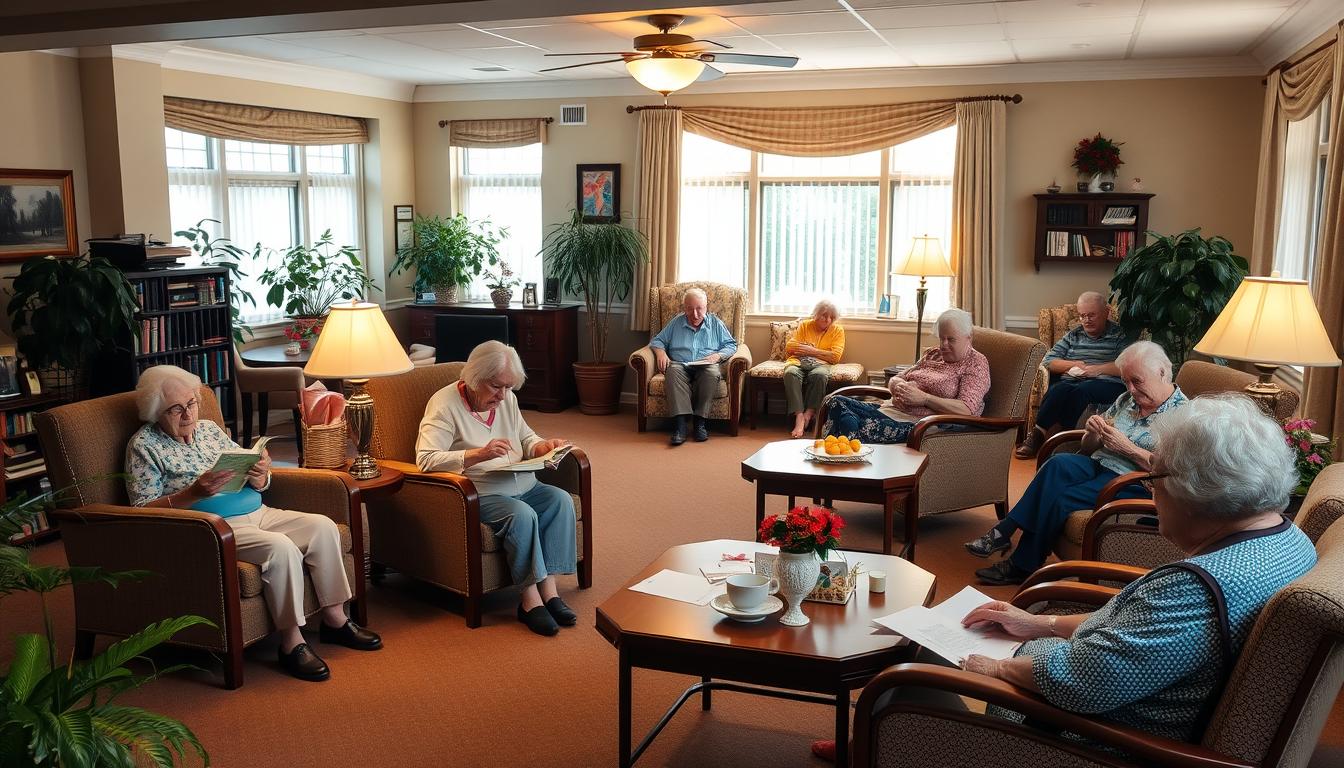Staying active is key for older adults. Geriatric physiotherapy exercises help keep strength and independence. These routines improve mobility and lower fall risks for those 65 and up.
Experts say aim for 60 minutes of daily activity. This can be walking, tai chi, or chair yoga to boost balance. Senior fitness programs mix strength training with flexibility. They support elderly rehabilitation and improve overall well-being.
Whether you’re in a hospital, clinic, or at home, there are exercises for you. From gentle stretches to targeted movements, geriatric physiotherapy offers many options. These exercises can be adjusted to fit different needs and abilities.
Understanding Geriatric Physical Therapy and Its Importance
Geriatric physical therapy is a special field for older adults. It helps improve their mobility, strength, and overall health.
What is Geriatric Physical Therapy?
This type of therapy aims to improve the lives of older people. It uses exercises that fit their age to keep them independent and active. Therapists work on building strength, flexibility, and balance. This helps seniors do everyday tasks more easily.
Benefits for Older Adults
Geriatric physical therapy has many benefits:
- It improves mobility and balance
- It helps manage pain and rehabilitation
- It boosts independence in daily tasks
- It treats conditions like arthritis and osteoporosis
Balance training is a big part of it. It helps prevent falls and keeps seniors stable. Therapists might use Tai Chi to help with balance.
Settings Where Therapy is Provided
Geriatric physical therapy is available in many places. You can find it in hospitals, clinics, nursing homes, and even at home. Home visits let therapists check the space and suggest changes for safety and independence.
Getting Started with Geriatric Physiotherapy Exercises
Starting a senior fitness journey needs careful planning and guidance. First, talk to your healthcare provider about any exercise limits or changes you might need. This is key for your safety and makes sure your workout fits your health.
Begin your geriatric physiotherapy slowly, focusing on the right form and control. Try to do some physical activity every day, even if it’s just a little. Aim for 150 minutes of moderate activity each week. This helps you get fitter while lowering injury risks.
Make sure your routine includes different types of exercises. Do strength training, balance exercises, and flexibility work at least two times a week. These are vital for keeping muscle, improving balance, and better movement.
- Start with chair-based exercises like sit-to-stand movements
- Practice single-leg balance to improve stability
- Perform gentle stretches to enhance flexibility
- Gradually introduce walking or low-impact aerobics
Consistency is important in geriatric physiotherapy. Regular exercise boosts your mobility, balance, and independence. It also lowers the chance of falls, a big worry for older adults. By sticking to a good exercise plan, you’re taking big steps towards a better life and keeping your independence.
Essential Lower Body Strength Training
Strength training is key for older adults to stay independent and mobile. Exercises that focus on the lower body can make daily tasks easier and lower the risk of falls.
Chair Stand Exercises
Chair squats are great for improving balance and making everyday tasks simpler. They strengthen your thighs and hips, making it easier to get up from chairs or toilets. Just stand up from a seated position and slowly lower yourself back down. Do this 10-15 times.
Leg Raises and Extensions
Leg raises work on several muscle groups. Side leg raises boost hip and thigh strength, helping with balance. Knee extensions, done while seated, strengthen thigh muscles, helping with walking and standing.
Hip Strengthening Movements
Hip hinge exercises are important for leg strength and balance, essential for daily tasks. Lunges also improve leg strength, helping with getting up from the floor and boosting confidence for harder tasks.
Do these exercises slowly and with control. Start with your body weight and add light resistance as you get stronger. Regular practice of these exercises can improve your mobility, balance, and overall life quality.
Upper Body Conditioning and Mobility
Keeping the upper body strong and flexible is key for older adults. Exercises for the upper body make it easier to do everyday tasks. For example, reaching for things or carrying groceries.

Wall push-ups are great for building arm and chest strength. They’re easy on the joints. Stand close to a wall, lean forward, and push back like a regular push-up.
Shoulder rolls are simple but effective for improving flexibility. Do 10-15 rolls in each direction to boost joint mobility. This helps loosen up the shoulders and increase their range of motion.
For arm strength, try bicep curls and triceps kickbacks with light weights or bands. Do 10 reps of each, aiming for 20 as you get stronger. Keep your posture right and breathe smoothly while doing these.
Diagonal shoulder raises work many muscles at once. Lift your arms diagonally across your body, switching between inward and outward moves. This boosts upper body mobility and strength.
Adding these exercises to your routine can greatly improve your upper body. It supports better mobility and independence in daily life.
Balance and Coordination Training for Fall Prevention
Balance training is key for seniors to avoid falls. Every year, over 25% of adults 65 or older fall, with 3 million needing emergency care. This shows how vital fall prevention exercises are for older adults.
Exercises that boost balance and strength can greatly lower fall risks. They improve coordination, muscle strength, and bone density. Here are some effective exercises to prevent falls:
Single-Leg Standing Exercises
Single-leg standing is a basic yet effective exercise. A 2022 study showed that those over 50 who couldn’t stand on one foot for 10 seconds were at higher risk of death in the next decade. Do this exercise near a chair or wall for safety. Aim for five reps, twice a day, to improve your balance.
Weight Shifting Techniques
Weight shifting exercises enhance balance during movement. They’re great for daily tasks like climbing stairs or getting in and out of a car. Start with small side-to-side and front-to-back shifts. Gradually increase the range as you get more comfortable.
Heel-to-Toe Walking Practice
Heel-to-toe walking, or tandem walking, improves your gait and balance. It’s like walking on a tightrope and challenges your balance in a safe way. Start with short distances and increase as you become more confident. Remember, regular practice of these exercises can greatly improve your stability and overall health.
Cardiovascular Exercises for Seniors
Cardio workouts are key for seniors. They boost heart health, help with weight loss, reduce stress, and improve sleep. The American Heart Association says they also lower risks of heart disease, stroke, and dementia.
Low-Impact Aerobic Activities
Geriatric physiotherapy includes low-impact cardio. These exercises are easier on the joints but offer great benefits. Some favorites are:
- Brisk walking
- Swimming
- Stationary cycling
- Pickleball
- Kayaking
Duration and Intensity Guidelines
The National Institute on Aging says cardio is vital for aging well. Aim for 150 minutes of moderate activity each week. Begin with 10-minute sessions and increase them slowly. This helps you build endurance safely.
Safety Considerations
Safety is critical in senior workouts. Watch your intensity during exercises. If you feel chest pain or severe shortness of breath, stop. Always talk to your doctor before starting a new exercise plan.
Cardio exercises are diverse. You can try marching, arm circles, and more to keep your heart healthy. Choose activities you like to make staying fit enjoyable.
Flexibility and Range of Motion Exercises
Flexibility exercises are key for older adults. They help keep joints moving and prevent stiffness. Stretching regularly makes it easier to do daily tasks like reaching or turning your head.
Geriatric physical therapy uses gentle stretches for big muscle groups. These include the neck, shoulders, back, hips, and legs. Stretching these areas can help with lower back pain from tight muscles.
To get the most from your stretching:
- Stretch slowly
- Hold each stretch for 10 to 30 seconds
- Repeat up to three times
- Avoid bouncing
Stretching exercises need little space and no special gear. You can do them standing, sitting, or lying down. This makes them great for elderly programs.
Always listen to your body while exercising. If you feel pain or have ongoing health issues, talk to your doctor or physical therapist first. Regular stretching will improve your flexibility and make daily tasks easier and more fun.
Core Strengthening and Posture Improvement
Core strength training is key for older adults to stay balanced and stable. Exercises that focus on the core can also improve posture and lower fall risks. As we get older, our muscles shrink, making it important to do specific exercises.
Seated Core Exercises
Begin with simple seated exercises to strengthen your core. Try leaning back gently and lifting your knees while sitting in a chair. These exercises work your abs without hurting your back. Do these exercises 2 to 3 times a week as part of your routine.
Standing Posture Drills
Standing exercises boost body awareness and alignment. Try wall slides to strengthen your back and posture. Stand with your back against a wall and slide down slowly, holding for a few seconds before going back up. This targets many muscles and boosts stability.
Back Strengthening Movements
Include back strengthening exercises for spine health. Bridge exercises are great for this. Lie on your back with knees bent and feet on the floor. Lift your hips, engaging your core and glutes. Hold for a few seconds before lowering back down. Doing these exercises regularly can help reduce back pain and improve posture.
Consistency is important in strength training for older adults. A study found that seniors who did core exercises five times a week for six weeks saw big improvements in balance and reach. Always talk to a healthcare professional before starting any new exercise to make sure it’s safe and works well.
Equipment-Based Workout Options
Adding equipment to your senior fitness routine can make your workouts better and help you move more easily. Resistance bands are great for older adults because they offer adjustable strength. This lets you increase the challenge as you get stronger.
Stability balls are perfect for boosting balance and core strength. They help keep your body steady, which is key to avoiding falls. Light dumbbells are also good for upper body exercises, strengthening your arms and shoulders.
Chairs are great for exercises because they offer support for those with limited mobility. You can do seated leg raises, arm curls, and stretches with a sturdy chair. The Centers for Disease Control and Prevention suggest 150 minutes of exercise a week for those 65 and older. This can be broken into shorter sessions throughout the day.
Always focus on proper form and safety when using equipment. Start with light weights and slowly add more as you get stronger. Aim to do strength training at least twice a week. This helps keep bones strong, improves balance, and boosts mobility.
By adding these equipment-based options to your routine, you can create a balanced senior fitness program. This supports your health and keeps you independent as you age.
Pain Management Through Movement
Geriatric physiotherapy exercises are key for older adults with chronic pain. Adding gentle movements to your day can bring relief and better mobility.
Gentle Stretching Techniques
Stretching is vital for elderly rehabilitation. Start with easy exercises like shoulder rolls, ankle rotations, and gentle neck stretches. These can lessen stiffness and boost flexibility, making daily tasks less painful.
Joint-Friendly Exercises
Low-impact activities are great for seniors with pain. Try walking, swimming, or chair exercises to strengthen muscles and improve joint health. These can help build muscle support around joints, easing discomfort and improving mobility.
Therapeutic Movements
Therapeutic movements like Tai Chi or yoga offer many benefits. They improve balance and flexibility and also reduce stress and joint pain. Many seniors find relief in these gentle, flowing movements.
Always talk to a healthcare professional before starting any new exercise. They can give advice tailored to your needs, ensuring your exercises are safe and effective.
Progressive Exercise Programming
Progressive exercise is vital for older adults wanting to get fit. It includes age-appropriate exercises and strength training. Start with simple movements and increase the intensity as you get stronger.
A good plan should mix strength training, cardio, and balance exercises. Do strength training two to three times a week, for 20-30 minutes at first. For heart health, do activities like brisk walking, swimming, or cycling for 150 minutes a week.
Being consistent is key in strength training for older adults. Start with light weights or bodyweight exercises. Then, slowly add more weight, reps, or sets as you get better. This method helps avoid injuries while building strength and endurance.
Adding balance and coordination exercises, like single-leg stands or tai chi, can greatly improve stability. It also lowers the risk of falls. Programs like Tai Ji Quan: Moving for Better Balance® use simplified Tai Ji Quan forms for fall prevention.
Only a small fraction of Americans aged 65 and older meet the CDC’s physical activity guidelines. By sticking to a progressive exercise program, you can become one of the active seniors who enjoy better strength, balance, and health.
Conclusion
Geriatric physiotherapy exercises are key for older adults. They help in improving daily life for those with mobility issues. A study found that physiotherapist-led exercises can slow down the decline in daily functioning among the elderly.
Strengthening exercises are great for older people with back pain. They can lessen pain, improve function, and reduce disability in seniors with back problems. This shows why strength training is vital in geriatric physiotherapy.
Geriatric rehabilitation aims to enhance mobility and balance in older adults. It also helps manage chronic pain and prevent age-related diseases. Plus, it boosts mental health through social interaction. A balanced exercise program can keep you independent and enhance your quality of life as you age.




